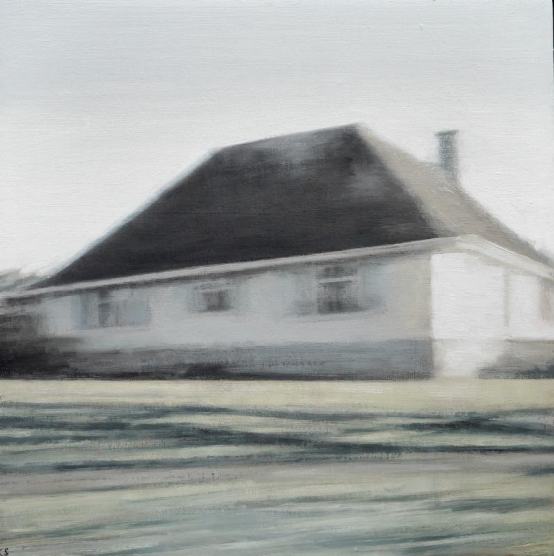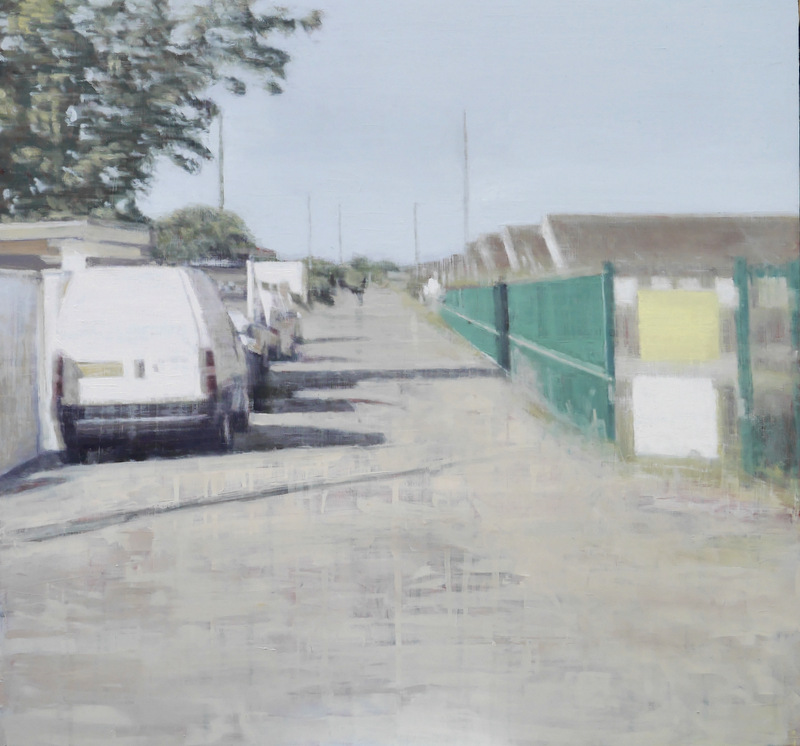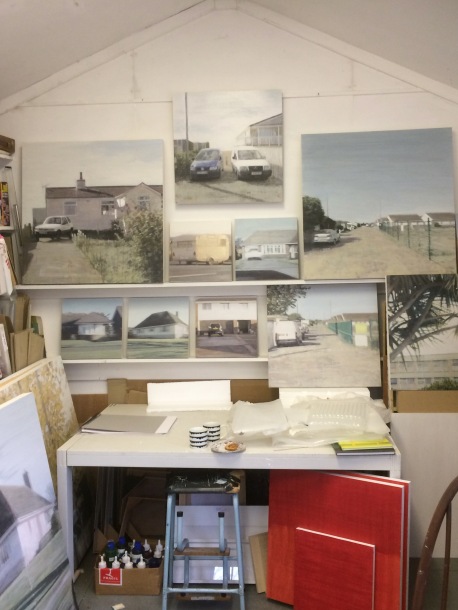A Studio Visit: Kate Sherman – Coast
“A thin veneer of immediate reality is spread over natural and artificial matter…” (V. Nabokov)
In advance of her forthcoming exhibition, entitled ‘Coast’at the ONCA gallery in Brighton (opening 20 June, 2019), I paid a visit to Kate Sherman’s studio in Ditchling, just seven miles north of Brighton. I had anticipated landscape-type developments from a previous show, ‘Rendlesham – New Paintings’ (also at ONCA), which I responded to back in November 2016. A lasting impression from that body of work was of being impressed with a highly skilful painterly photorealism applied to representing the superficial banality of a Forestry England location. Sherman’s treatment and presentation of the subject matter gave rise to brooding possibilities about memory and longing, fixed and transfixed by the eternal phenomenon of painting.

This metaphysical treatment of the ordinary and everyday continues apace in the Coast series. Seeing the new work, both finished and in progress, also reinforced expectations of Sherman’s continued evolvement of painting skills, utilised to registering a certain kind of ordinary yet uncanny subject matter that might represent far more than what is initially perceived. Coast, the exhibition, will undoubtedly invite the viewer to contemplate a potentially loaded subject matter that will emerge from first impressions of commonplace imagery. But this deeper field of enquiry will again demand a slightly abstracted, subjective response to aspects of the everyday and the unremarkable in the way that she re-presents them. Sherman’s paintings demand a slow looking – not the snapshot glance that the photograph often presents. But what they ‘give up’ to the viewer will oscillate between the nebulous and the clear.

Sherman’s ‘drive-by’ house paintings do not explicitly present a series of coastal views, as there is no immediately obvious coastal scenery. An exception is ‘Coast 11’, where we possibly see a glimpse of beach sandwiched between two small vans. This slim portal may reveal the sea in the furthest distance; only the sky and sea is burnt out, overexposed in photographic terms, by a strong source of reflected light.
As for the potential inland vista of distant hills there is also little evidence, although the exception here might be ‘Coast 15’, which is a square format dominated by a parked caravan taking up at least 50% of the area of the composition. On the right hand edge, just into the top half of the mid-section, are two thin bands of grey. The bottom strip is the roof of a building and the top, lighter shape, could well be a strip of mid-distance hillside, toned down by aerial perspective. Or maybe it’s another rooftop?

The other paintings in the series suggest a looking to one side, or immediately ‘along the way’, en route to someplace or other. This lack of land or seascape views suggests the enclosed strip of the carriageway, a corridor of sorts, through the urbanised landscape. Here the mundane and the familiar, seen fleetingly as blurred, foregrounded swathes of tarmac, plus the odd picket fence, a section of the canopy of a tree and a variety of shadows, adds an aura of emptiness and anonymity – perhaps even loss or disappearance. For example, a number of vehicles (low budget cars, vans and caravans) appear as the main figures in the paintings, as there are no actual people or even animals, domestic or wild. These are matched in their dullness by drab bungalows and other unremarkable modern buildings generally enclosed by sections of public space, cut grass or monochromatic skies. We could be travelling the minor ‘A’ roads of southern England in a daydream or state of restrained, bearable ennui. These places, usually only glimpsed at mid-journey, are usefully fixed by the intervention of the camera in Sherman’s preparatory studies. Transformed into paintings, however, there might be more to the potentially humdrum and prosaic narrative.
In an interview with Jessica Wood (from Arts Media Contacts in Lewes), about these paintings, Sherman has explained that she “grew up on the coast in Dorset, and had quite an idyllic childhood by the sea. With this series I am trying to recapture some of the feelings of innocence and simplicity connected with childhood… There are also ideas around loss.”
So, this occlusion of the view of land and sea, where buildings and vehicles might block the view of a child returning to her routes (prompting the bored but yearning, “Are we nearly there yet?” soundtrack of many a long journey), could make some sense. Except that the artist is no longer a youngster, and she could be reflecting upon both an equally pleasing and poignant intermixing of emotions.
Time is certainly an element too. As the here and now is so impossible to pin down, only the past exists as something reasonably concrete (though surely the past is distorted by memory itself and can only be placed in the context of the present). That the artist, and by implication, the viewer, only see these types of empty but potent scenarios from the Coast series fleetingly, might suggest that, were it not for the ‘memory technology’ of the camera, such representations and views of places might be quickly forgotten or left unrecorded.
As we may recount, those early untroubled years that, ideally, most children have, may well have seemed like a golden age when time itself was stretched out into an almost endless ‘now’ – but from the perspective of adulthood we experience time as flowing faster and with greater urgency. This adds a tone of reversed premonition to the work, which activates and energises a feeling that we might sense in the subtle painterliness of the application and materiality of the paint. Message and medium are interconnected by varying qualitiesof light, colour, texture, composition and space, where content is associative and liminal rather than presenting a clearly defined narrative.

It’s also appears to be very quiet in these images; yet the silence of these physical ‘outside’ spaces and the mobile and immobile structures (homes, caravans and vehicles) that assign human ergonomics to a sense of place and space, might sonically echo or rekindle memories suggesting the fourth dimension of anthropic time. By this I mean the duration from the present to the personal past as experienced by reminiscence, or the unexpected surfacing of episodes of gentle trauma. In pictorial terms, the depth of distance is flattened and foregrounded, despite the occasional perspective and vanishing points of receding roads and orthogonal, architectural elements. There is a draining out of colour too and here the colour palette of Agnes Martin or Giorgio Morandi springs to mind, encompassing quietude and tonally meditative imagery. The Coast paintings juxtapose society’s urban clutter against flat, grey-blue skies, where greenery is controlled and piecemeal. This territory, viewed and reconstituted with cool restraint, makes for an agnostic, temporal and secular palimpsest in subjective Protestant tinctures.
Sherman’s reconstituted photo-album records urban dwellings that look somewhat off-track, where vehicles are often seen from the rear or in semi-private roads. These are places you might only visit if you had taken a wrong turn or you would only need to go to if friends or relatives lived there – or perhaps these are the real destinations, where the goal is to reach the people and not the picture postcard coastal resort.

Initially, the imagery reminded me of a passage from ‘Transparent Things’, Vladimir Nabokov’s 1972 novel:
“Novices must learn to skim over matter if they want matter to stay at the exact level of the moment. Transparent things, through which the past shines! … A thin veneer of immediate reality is spread over natural and artificial matter, and whoever wishes to remain in the now, with the now, of the now, should please not break its tension.”
Nabokov’s quirkily written novella tells the story of the main character’s recollection of his four trips to a village in Switzerland over almost two decades. The author presents a journey through a kind of metaphysics of memory, where reminiscence is more than mere factual recall due to its subjective nature and has an immediate relationship to an immaterial sense of past reality based in time. Every object (a stone, a pencil…), or familial historical event, is loaded with known and unknown histories leading to consequences driven as much by chance or design as by desire.
In Sherman’s paintings for Coast, specific, personal history might be deliberately obscure or non-descript, as the author passes interpretation over to the onlooker, as if a potentially self-obsessed investigation is being deflected into a more shared experience. The thinned application of oil paint, gently hued and subtlety nuanced in interconnecting planes of conjoining perspectival and flattening shapes, acts as “a thin veneer of immediate reality” to evoke a response specific to a new witness.
As Sherman further explained to Jessica Wood:
“I want the viewer to respond to the experience or feeling in the painting, rather than a specific place; keeping it vague makes it more likely that something may trigger a memory and perhaps provoke an emotional response.”
These paintings also take the viewer on a journey of sorts, only this is a through the viewfinder snapshot revealing of the artist’s outings. Because of the blurring, indicating the observer’s speed in relation to the subject matter, and the predominant angle of view, there’s a sense too that the vantage point is from the side window of a car. In this sense, the commonplace is framed and composed, as a traveller would see it – not constructed or fabricated in the classical, 17thcentury landscape tradition from Claude Lorrain onwards. The cropped image, art historically, may owe something to Degas and his acceptance of the viewfinder framing of immediate reality for some of his compositions (e.g. see ‘Carriage at the Races’, 1872. Museum of Fine Arts, Boston); and throughout the 20th century to the burgeoning ascendancy of visual representation, and notions of realism, mediated by the camera lens in all its various manifestations and formats.

But Kate Sherman is not strictly a photorealist and a composition such as ‘Coast 18’, where barely hidden drips of paint disrupt the traits of photorealism, we see a painter (or rather, the work) in a positive, questioning state of transition. Coast promises to present a fascinating series of paintings; real physical images rendered by hand, that are not the result of a purely reproductive, mechanical or copying process. The attentive audience will become aware of a sense of time – not just in the time to patiently make and to craft the paintings in symbiotic relation to the source of the image from a particular mode of primary research, but to their own phenomenological experience of place and memory. In relation to photography, this almost expressionless painting may bare a greater verisimilitude to the veneer of the ‘real’, sparking personal and familial memory and associations enabling us to dig deep.
Geoff Hands (April 2019)

Links:
Kate Sherman: http://www.kateshermanpaintings.co.uk
‘Rendlesham – New Paintings’ review:
https://fineartruminations.com/2016/11/08/out-of-this-world-rendlesham/
ONCA: https://onca.org.uk
Jessica Wood at AMC: http://www.artsmediacontacts.co.uk